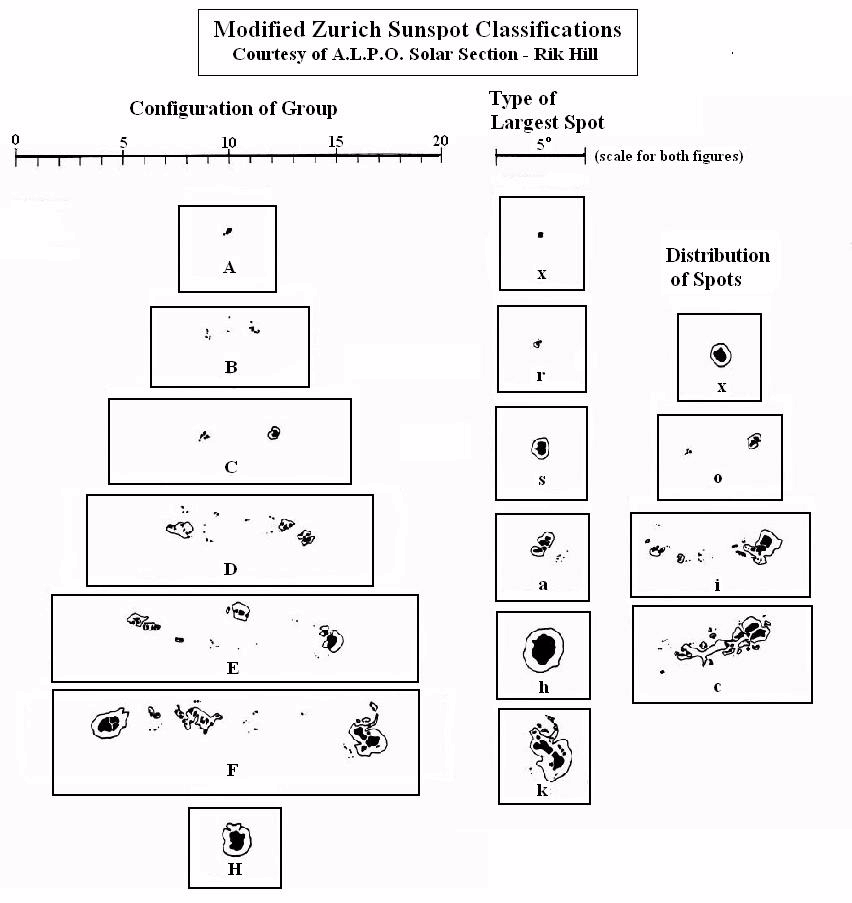Can Sunspots Predict Solar Flares?
Jack Kramer
Yes! It has been found that groups of sunspots with certain characteristics have virtually a 100% probability of producing flares within a 24-hour period. Flares are eruptions that take place in and around sunspot groups and eject vast amounts of energy across most of the electromagnetic spectrum. It is subatomic particles from these flares that disrupt radio traffic and produce aurorae on the Earth. If the flare is sufficiently large, it might be visible in white light (the way most of us observe) as a brilliant spot on the photosphere (visible surface) of the sun that typically will last from 10 to 20 minutes, and possibly longer.
Solar astronomers use the Zürich-McIntosh Sunspot Classification system when reporting activity on the surface of the sun. This system characterizes sunspots based on three criteria: the configuration of the sunspot group, the type of the largest spot in the group, and the distribution of the spots within the group.
If you want to try your hand at classifying sunspots, here's how to interpret the Zürich-McIntosh chart.

Column One
Line A - the configuration consists of a unipolar (essentially a single spot) group with no penumbra
Line B - bipolar group with no penumbra on any spots
Line C - bipolar group with a spot surrounded by penumbra on one end
Line D - bipolar with penumbrae on spots at both ends and a length less than 10 degrees
Line E - same as above but 10 to 15 degree length
Line F - as above but length greater than 15 degrees
Line H - unipolar group with penumbra
Column Two (type of largest spot)
x - no penumbra
r - rudimentary penumbra, usually only partially surrounding the largest spot
a - small symmetric spot with irregular penumbra and the umbra within separated; N/S diameter 2.5 degrees or less
s - small, symmetric spot with a dark, circular or elliptical penumbra
k - large, asymmetric spot like "a" but N/S diameter greater than 2.5 degrees
h - large symmetric spot like "s", but N/S diameter greater than 2.5 degrees
Column Three (sunspot distribution)
x - solitary spot
o - leader and follower spot with few or none between
i - numerous spots between the leader and follower
c - many spots between leader and follower with at least one spot in between having a penumbra
(The "leader" spot refers to the one closest to the western limb of the sun -- the "leading" spot as the group moves across the face of the sun.)
The groups most likely to produce flares are classified as types Fsi, Fki, or Fkc. The illustration below shows how such a group might appear.

These groups contain prominent spots at both ends, extend at least 15 degrees across the face of the sun, and the spots at the ends are surrounded by penumbra.
Amateur astronomers are encouraged to submit their observations, and in particular, solar flare reports to the SOLNET group of ALPO (Association of Lunar and Planetary Observers). The ALPO web site is at:
http://www.lpl.arizona.edu/alpo
Your solar observation reports may also be submitted to a web site that disseminates amateur data to professional solar observers who may be clouded out. The following is the URL:
http://solar.uleth.ca/solar/www/sunobs.html
This is the type of observing that is pure serendipity -- there is no way you can "plan" to see a flare. It's simply a matter of knowing what to look for. ...And observing the sun regularly.





